Gluten-Free Cinnamon Raisin Bread
This Gluten-Free Cinnamon Raisin Bread is soft, fluffy, and makes for the perfect slice of toast. With raisins and cinnamon all throughout, this will satisfy your sweet bread craving – and makes the best French toast & bread pudding ever. It’s also vegan and top-8 allergen-friendly.
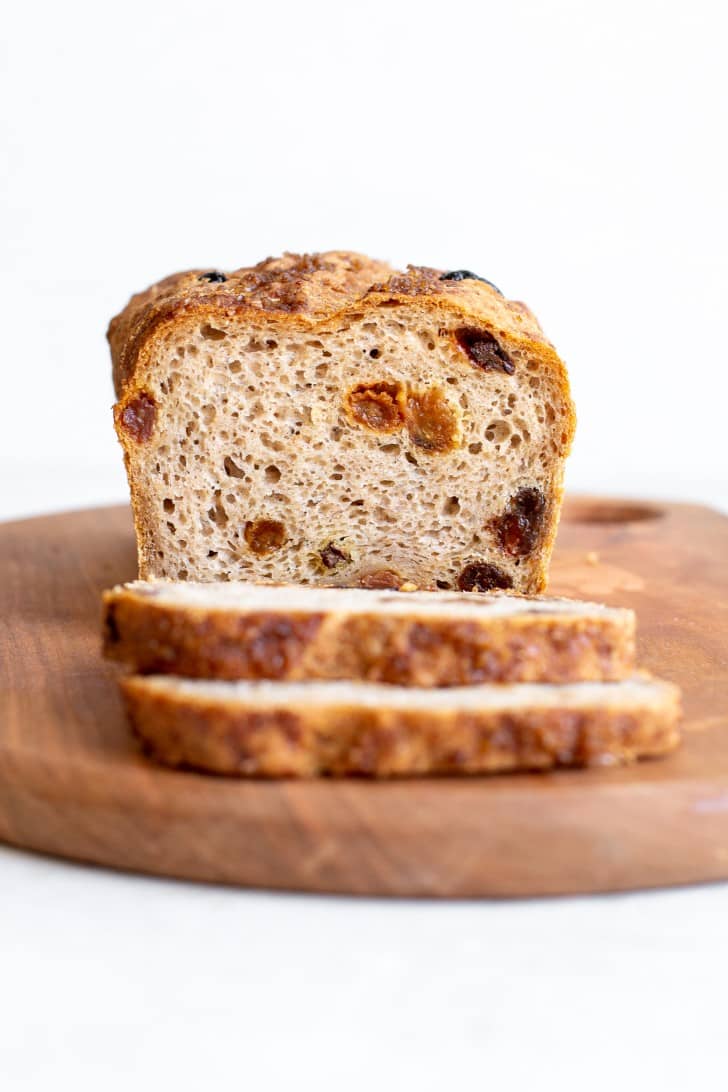
Meet the best gluten-free cinnamon raisin bread you will ever taste. Oh man, I am in love with this loaf. Light, fluffy, easy to make, not too sweet, full of fragrant cinnamon flavor, topped with cinnamon sugar, with raisins in every bite. This gluten-free cinnamon raisin bread became a quick favorite.
This cinnamon raisin bread is based on my oh-so-popular gluten-free bread recipe – which is a light and fluffy loaf that satisfies everyone I’ve ever shared it with, gluten-free or not. You could definitely make a sourdough version of this as well if you prefer!
You’ll definitely want to check out all of my gluten-free bread recipes!
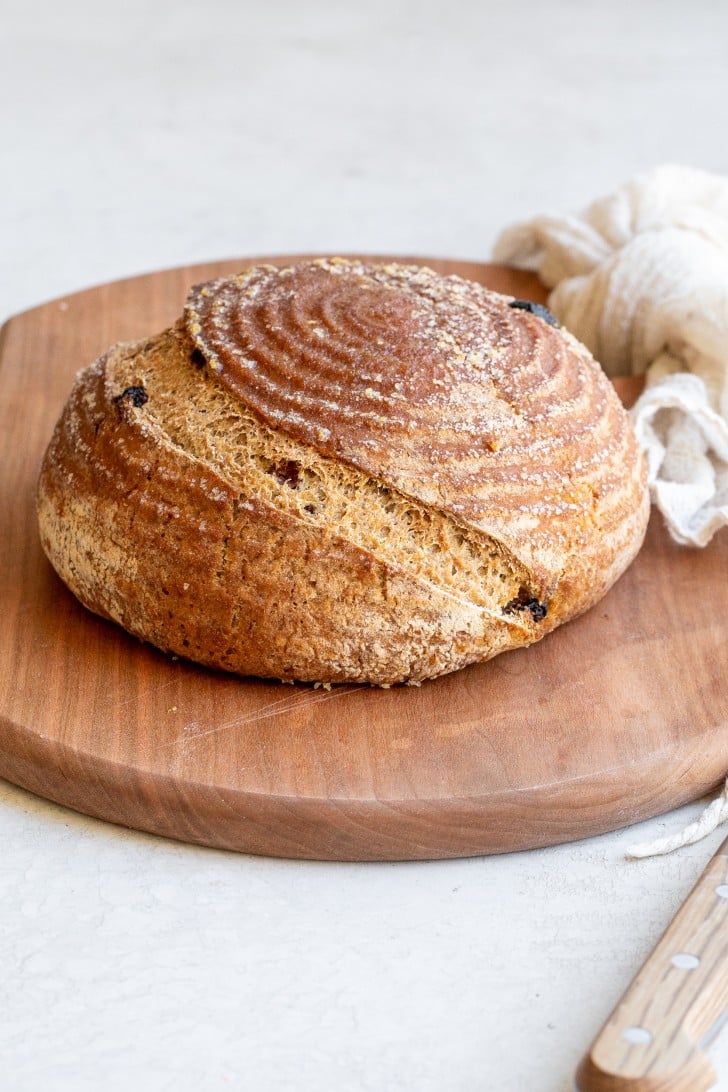
Which gluten-free flours should I use?
I don’t use blends in my recipes, because they aren’t as consistent as blending your own flours. This takes a bit more work and a few more ingredients on hand, but I think the effort is worth it to have consistent results! The flours we use for this recipe are tapioca flour, potato starch, brown rice flour, sorghum flour, and millet flour.
This combination balances the starches and the whole grain flours to make a bread that is both light and fluffy without being a pure white bread, since we get the added fiber and nutrients of the whole-grain flours.
If you would like to use a mix, I recommend using my homemade gluten-free bread flour blend. If you prefer a store-bought blend, I like this multi-flour blend from Vitacost. This blend uses very similar ingredients to the ones this recipe calls for, with no additives or gums.
Which yeast should I use for gluten-free bread?
For this cinnamon raisin bread recipe, we use active dry yeast. Make sure your yeast is gluten-free, as not all active dry yeasts are. I use this active dry yeast from Bob’s Red Mill. This yeast requires activation with warm water and sugar – we use maple syrup in this case! After mixing with warm water and maple syrup, the yeast should bubble and foam up in about 5 to 10 minutes. If you don’t see any activity, it’s possible your yeast was old or the water was too hot or too cold (too hot will kill the yeast, too cold won’t activate it).
I have not tested this recipe with instant yeast. So, I cannot say with certainty whether it would work or not.
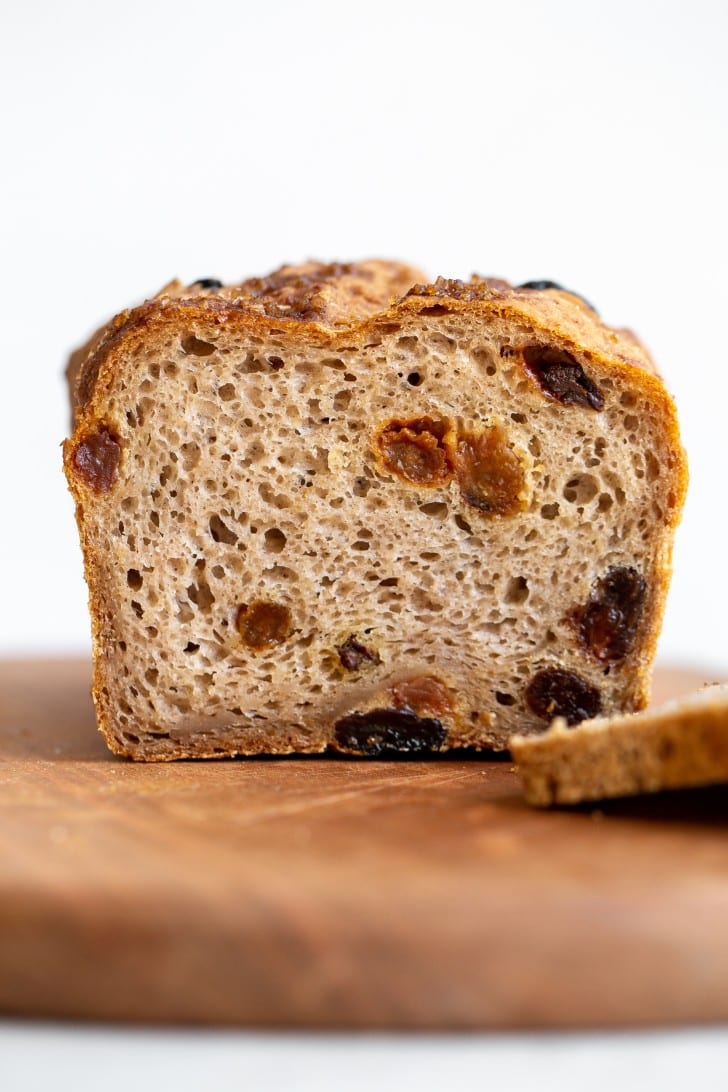
What is psyllium husk?
Psyllium is a form of fiber that is derived from the husks of plantain seeds 1. It has a lot of health and digestive benefits, but it’s the gelling, fiber-filled aspects of the plant that we’re after here!
Psyllium husk is our gluten for this bread: it provides the binding properties and elasticity that make the dough be workable and allows us to knead it and shape it just like a traditional gluten dough. It gives the structure and support for the bread to rise, as well.
Substitutes for psyllium husk?
From my experiments: you need psyllium husk for good gluten-free sourdough bread. For my bread recipes, I wouldn’t try to replace it. Psyllium helps make the dough workable, so it doesn’t squish and stick all over the place. It’s also what makes your bread chewy and stretchy.
NOTE: psyllium husk and psyllium husk powder are different. You want the full husk for this recipe and all of my other bread recipes. You can generally find it more easily anyways – I usually find it in the supplement area of most grocery stores. The powder is much more absorbent and I have not tried it in my tests, but I’ve seen others mention that you can use 75% of the amount called for in psyllium powder – so for this recipe we use 20g psyllium husk, if you have powder, you’d want to use 15g.

How to make Gluten-Free Cinnamon Raisin Bread
- Activate the yeast in warm water, with some maple syrup to help give it a boost.
- Mix up the psyllium gel which acts as our gluten in this recipe and helps make the dough easy to work with.
- Combine all the flours and dry ingredients in a mixing bowl, then add in the activated yeast and psyllium gel. Mix in a stand mixer or by hand until a dough forms with no dry spots.
- Mix in the raisins and fold in until completely incorporated.
- Let the dough rise for one hour for the first rise, and then knock the air out, shape, and place in your loaf pan or banneton for the second rise.
- Score and bake the bread until golden brown and delicious! If you’d like, you can coat the bread in cinnamon sugar before baking for a sweet topping.
- Cool completely before cutting into it – this will help prevent the bread from getting gummy! It’s definitely the hardest part.
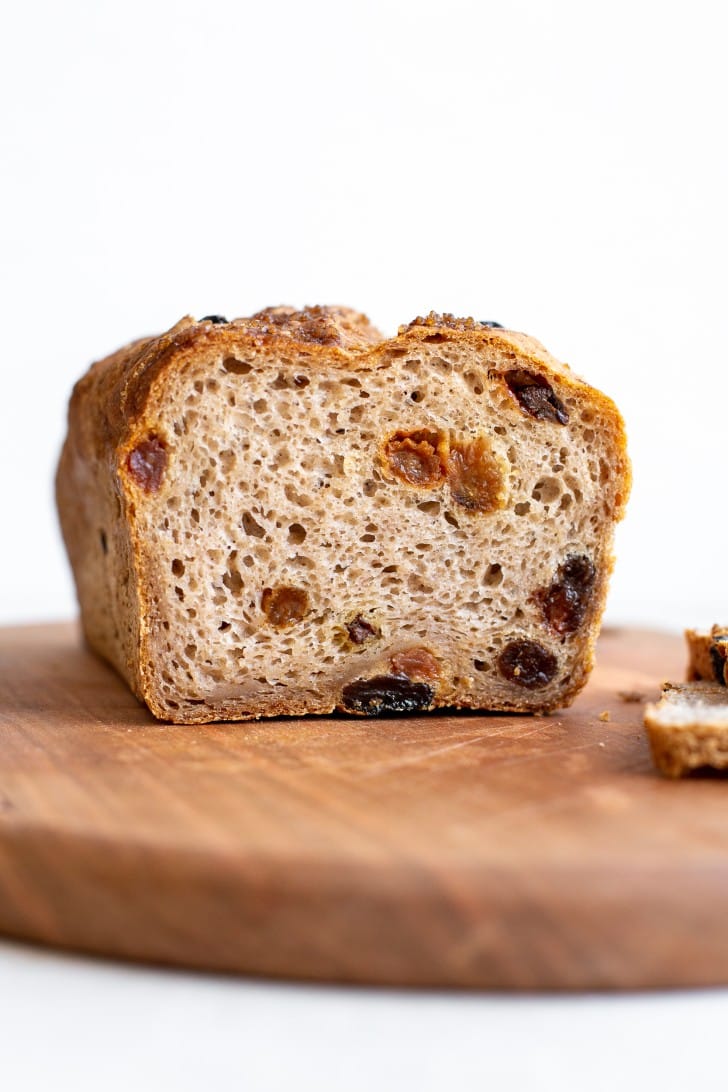
Want more delicious gluten-free bread?
- Homemade Gluten-Free Bread
- Easy Gluten-Free Pizza Crust
- Easy Gluten-Free Sourdough Focaccia
- The Best Gluten-Free Sourdough Pizza Crust
- Homemade Gluten-Free Bagels
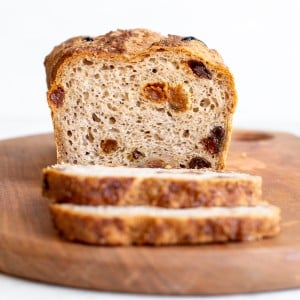
Gluten-Free Cinnamon Raisin Bread
- Prep Time: 20 minutes
- Rising Time: 2 hours
- Cook Time: 1 hour 15 minutes
- Total Time: 3 hours 35 minutes
- Yield: 1 loaf 1x
- Category: Bread
- Method: Baking
- Cuisine: Gluten-Free
- Diet: Gluten Free
Description
This Gluten-Free Cinnamon Raisin Bread is soft, fluffy, and makes for the perfect slice of toast. With raisins and cinnamon all throughout, this will satisfy your sweet bread craving – and makes the best French toast & bread pudding ever. It’s also vegan and top-8 allergen-friendly.
Ingredients
To activate the yeast
-
7g (2.5 tsp) active dry yeast
-
100g warm filtered water
-
40g maple syrup, honey or cane sugar
For the loaf
- 20g whole psyllium husk
-
355g filtered water
-
480g homemade gluten-free bread flour blend or (80g potato starch, 60g tapioca flour or arrowroot flour, 125g sorghum flour, 125g brown rice flour and 90g millet flour)
-
12g sea salt
- 4g cinnamon
- 55g raisins, soaked in hot water for 10 minutes and then drained
Instructions
-
In a small bowl, combine the yeast with the sweetener of your choice and warm water, between 100-110℉. It should feel warm, but not hot, to the touch. Let it sit to activate for about 10 to 15 minutes. You should notice it start to bubble, and then it will get nice and foamy on top.
-
In a bowl or liquid measuring cup, mix together the psyllium husk and water. Whisk together, breaking up the psyllium, and let it set for a few minutes until it’s thickened and gel-like.
-
In a large mixing bowl or the bowl of your stand mixer, mix together all of your flours, starches, and salt. Whisk to combine.
-
Add the psyllium gel and the activated yeast mixture to your dry ingredients. If using a stand mixer, fit it with the dough hook and let it mix up the dough until combined and smooth, scraping down the sides a few times during the process, and flipping the dough around to make sure it’s fully mixed on the bottom too. You can also do this by hand. If doing it by hand, I like using a dough whisk to get it mostly combined. Then, turn it out onto the countertop and use your hands to knead the rest of the flour in. Once it’s mostly combined, mix in the raisins.
-
Bulk ferment the dough for 1 hour. I simply leave it in the mixing bowl, covered with a clean tea towel, to rise for one hour in a warm place. You should notice that the dough will just about double in size during the hour, and become nice and puffy.
-
After the bulk ferment, knock the air out of the dough (give it a punch, or flip it onto the counter and squish it firmly against the counter top) and knead/shape it into your desired shape. Then, place it in the banneton (seam side up) – I like a 7″ banneton, or a loaf pan (seam side down – mine was 8.5 x 4.5″) for the final proof.
-
Cover with a tea towel and let the loaf rise for one more hour in a warm place. It should just about double in size again. Preheat the oven to 425℉ while it rises with a Dutch oven inside, if using.
-
Once it’s risen, score the bread (carefully flipping it out of the banneton onto parchment or a silicone sling if baking in a Dutch oven). If you’re baking in a loaf pan, you may want to brush the top with oil to get a nice golden crust. You can also sprinkle with cinnamon sugar, if desired. It makes a delicious sugary crust!
-
Place into your baking vessel if using a Dutch oven. If using a loaf pan, just place right into the oven. Bake for 1 hour and 15 minutes, removing the lid for the last 15 minutes if baking in a Dutch oven. It should be golden brown and crusty.
-
Remove from the baking pan and set on a cooling rack to cool completely. This is definitely the hardest part, but you really need to let the loaf cool completely so the inside can set. I try to let it cool overnight, but you’ll want to let it cool for at least four to five hours. It should be fully cool to the touch before cutting into your loaf.
-
Slice and eat. This bread is great raw, toasted, or however else you want to enjoy it!
Notes
Oat flour is also great in this recipe, in place of all or part of the sorghum/brown rice flours. I recommend experimenting with different grain flours to find the combo you like best!
Keywords: cinnamon bread, cinnamon raisin bread, gluten-free bread, gluten-free cinnamon raisin loaf


This looks delicious! Is there a substitute for the Millet flour? We have an allergy. Many thanks for sharing!
If I wanted to use eggs instead of psyllium husk, how many would you use? We have an abundance of egg layers at our house an no egg allergy..
Hi Jessica, unfortunately, psyllium and eggs are substitutes for one another, and adding eggs would throw off the liquid ratio in the recipe. Psyllium makes the dough workable similar to a gluten dough, and eggs would make the dough thinner and more sticky. I recommend sticking with the psyllium for this recipe!
You mentioned we could make it as a sourdough. With the discard or fresh aged appropriately? Please explain
Thanks
Hi Shari, you’d want to use my sourdough recipe, increase maple syrup by 20g, reduce water by 20g, and add in the cinnamon and raisins as stated in this recipe.
What size of pan or banneton do you recommend ? Looks delish !
I used an 8.5×4.5″ loaf pan for this, and would recommend a 7″ banneton for a round loaf!
Made this today and everybody loves it!! I think next time I’ll experiment with even more raisins! Also, I was so happy to see you soak your raisins too, it really makes a difference in baked goods! I made this in the 1lb Pullman Loaf pan with the lid for the first hour and removed the lid for the last 15 min. I wasn’t sure if I should score it in the loaf pan, so I did it anyway and did a little light olive oil on the top. Next time I’d probably leave off the olive oil altogether to see which we like better. I may even consider attempting a cinnamon swirl of some kind before the second rise, as it was very workable at that point! Thank you so much, this recipe is a winner!
★★★★★
So glad you’re loving it, Tina!! You’re so right that I forgot to say to score the bread – thanks for pointing that out! And more raisins are always welcome :D
Hi! I would love to make this but I can’t eat rice and anything made from it. Do you think there is anything or two things that could replace the rice flour? Thank you!
Hi Alene! Yes, absolutely – you can replace the rice flour with oat flour, millet flour, or even more sorghum flour. You’ll just want to make sure the combination of grain flours totals 340g. Enjoy!
Thank you so much! Making it asap and will let you know.
Please how do I convert these measurments
It’s much more efficient to bake gluten-free bread with weight measurements than with cup measures! I recommend getting a scale if you’ll be making gluten-free bread with any kind of regularity. You can find them for around $10 on Amazon or at Walmart/Target. And you’ll dirty a lot fewer measuring cups/spoons :) you can convert the measurements online, but I definitely recommend a scale for the best results.
I really enjoyed this recipe! Haven’t had cinnamon-raisin bread in so long since going gluten-free, so this is definitely worth making. Thanks for another great bread recipe :)
★★★★★
So glad you enjoyed it!! Thanks for the feedback :)
Have you substituted the VitaCost gluten free flour mix for all the flour in this recipe? If not, do you think there is a good chance it would work? Thanks!
Yes, I believe I did test this one with that mix – that mix is great and has worked for just about all the recipes I’ve tested with it as I remember! :)
This bread looks good and I’d like to try the recipe, but I would prefer having directions as to how much of each ingredient (cups, Tablespoons,
teaspoons, etc.) because I don’t know how to convert them. Thanks.
Hi Andrea, I’d recommend getting a kitchen scale if you’re going to be baking gluten-free bread with any regularity. You can find them for about $10 and will provide much more accurate results. I never use volume measurements for these recipes so if I were to give them, they’d be untested and not super accurate.
Hi, I’m a little confused. The recipe calls for millet flour but that’s not included in the description and you suggest it as an alternative in the notes after the recipe. Is it necessary?
Hi Jessica, I love this recipe as written with the millet flour, but I also tested with more sorghum instead of the millet and that also works well, so if you prefer to make it without, it will still work well! Hope this clarifies :)
Any suggestions for replacing the potato starch? I’m currently eliminating nightshades.
Tapioca or arrowroot starch are both good replacements!
this looks amazing I’m going to try and make this on Tuesday since it’s actually going to be cool outside and I won’t heat up the house! Is it possible to make a cinnamon swirl in the center?
I hope you love it, Shaelee! If you’d like to do a cinnamon swirl, you can roll out the dough into a rectangle (make sure the width isn’t wider than your pan), sprinkle it with cinnamon, and roll it up to place in the pan :) enjoy!
To make it cinnamon swirl you would want to mix cinnamon and brown sugar together. Spread thin layer of soft butter or vegetable spread on the rectangle dough. Then sprinkle the cinnamon sugar over the butter and then roll tightly. Pinch seams closed. Put in pan seam side down. Let it do the second rise then bake.
I’m not sure what went wrong, I did 4x the recipe, and the loaves got very dark and hard in the pans around 25 minutes before the 1 hr 15 minutes were up. The exposed raisins taste burnt. Was the oven supposed to stay at 425F? I only saw one temp. in the recipe. The loaves also barely rose in the oven, although they did rise during the two proofings. I didn’t have a mixer, so I mixed it by hand, but even if that affected the rise, it shouldn’t have caused darkening and hardening. I also subbed besan flour for millet, but those are the only two changes I made. Do you have any ideas why this may not have worked? Thank you!
Hi Mei-Ling, I never bake with besan flour so I’m not sure entirely how that would affect things. Are you sure your oven doesn’t run hot? That would explain the quick darkening and burning. If the dough rose too long at room temperature, there may not have been anything left to rise once it went into the oven, so you can try putting it in earlier next time. Are you sure nothing got changed with multiplying the recipe? Sometimes an ingredient gets incorrectly calculated and that can affect things. There’s so many factors at play with bread that it’s hard for me to know what exactly goes wrong.
Thank you so much Rachel. All good questions. My oven is fairly accurate in terms of temp, but I did turn it on low briefly to help with the proofing and finished the proofing in the oven. Maybe it did all its rising then (room temp was very cool). I only let it rise slightly longer than you suggested. I think next time I will cover the bread for the first part of the baking, I’ve noticed that when I make bagels in this oven, they are a little too brown by the end of it. Maybe if I put 3 loaves worth in 2 pans, I will get a higher loaf? My loaves were only as tall as biscotti, so I would love to see more height. Next time, I also won’t make so many loaves so I can ensure I have the right measurements for the ingredients. Thank you!
Hi, what size pans were you using? It definitely sounds like they were too big if the loaves were so thin! I would recommend covering them if things tend to brown too quickly in your oven.
These were 2 lb pans, so about standard size I think?
I tried making this recipe and followed the bread flour combo to the T. My dough was very wet and I could not knead. I added more flour for kneading and now it hasn’t risen and has been sitting for over an hour. :(
Any suggestions?
Hi Tricia, without more information it’s hard for me to know what’s going on. Did you change anything else about the recipe?